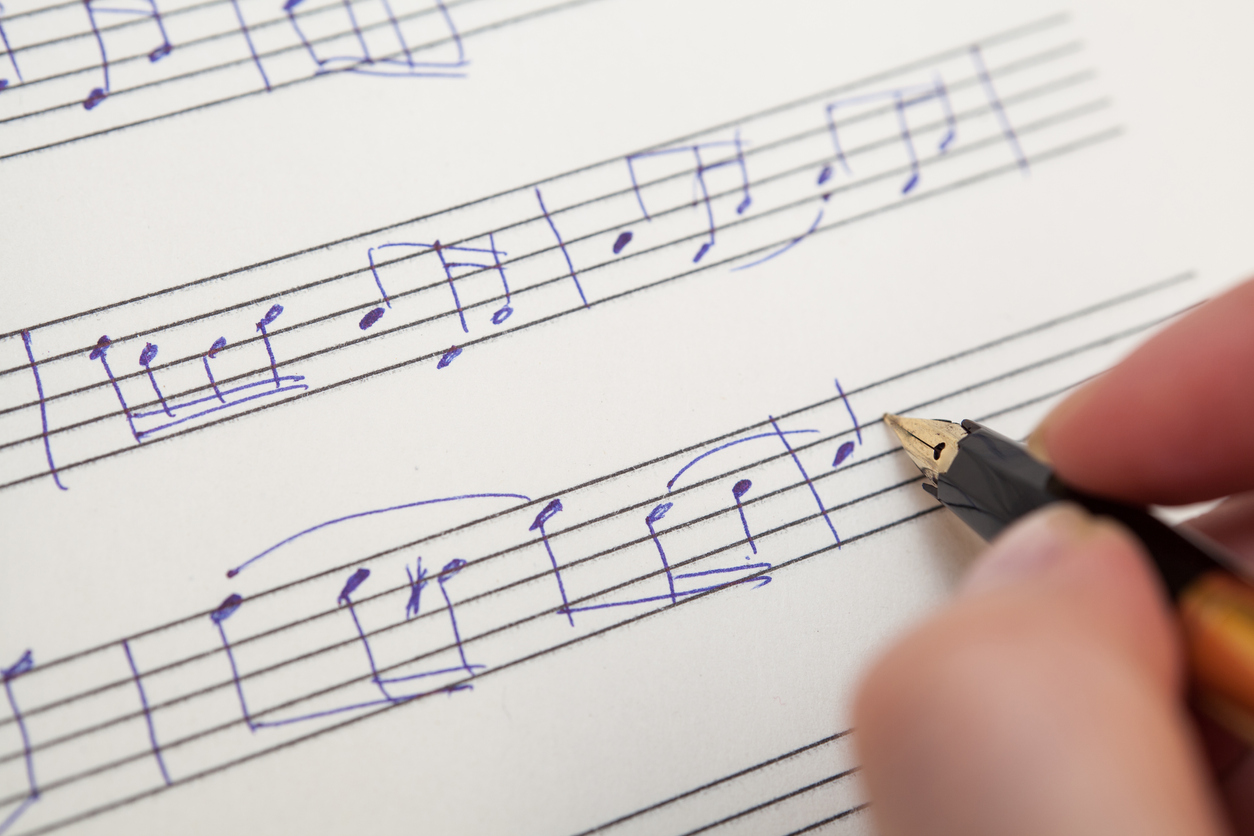Do you dream of someday writing a popular song — one that people just can’t get enough of?
You can! No matter where your melody-writing skills are today, you can learn to write stronger ones.
There are tips and techniques that pro songwriters use to keep listeners engaged — and even to make them want to listen to the same song over and over.
But all melodies aren’t created equal. Even if yours is written well structurally, it won’t be as effective if it doesn’t reinforce the theme or concept, the compelling unifying idea you’ve chosen for your song.
If you want to tell a strong story, build your songs around strong themes (I always suggest you start there.) You’ll need to keep that theme in mind while writing your melodies as well as your lyrics. In this post, I’ll show you how.
How Do Your Melodies Reinforce Your Song’s Main Idea or Theme
These days, songwriters use the term “storytelling” loosely. The iconic storytelling songs you might recognize from the ‘60’s or ‘70’s wouldn’t necessarily be hit songs today.
But imagine you can’t hear or understand a song’s lyrics. Maybe the lyrics are in a different language, for example, or you’re in a noisy room where the words get drowned out.
If the melody fits, you could at least generally guess what the song is about. Is it a love song, a sad song, a fun dance tune, or an angry protest song? Where are the important parts? Your music will usually (although not always) support your lyrics by evoking emotions that support your theme.
To see how melody and theme work together, think about every song that you write as an emotional journey.
For example, if you’re writing a party song, you’ll want an irresistible beat that gets listeners moving right away, and possibly build to a little craziness near the end.
If you’re writing a love song, you’ll want to rope your listeners into that emotion in the beginning, and then tug on their heartstrings even more as the song progresses.
When you can create these journeys effectively, you’ll create memorable songs — because people won’t always remember what you say, but they’ll remember how you made them feel (thanks, Maya Angelou.)
If you’ve already read the steps we outlined in How to Write a Song and How to Compose Music, this post will dive deeper into the melody step in each of those processes.
But first, some basics.
Musical Terms All Melody Writers Should Know
We won’t get too technical with the music theory here. If you want to learn more, check out this post on chord progressions.
But there are a few terms you should be familiar with if you want to write strong melodies.
- An interval is the distance between 2 pitches. In melodies, it refers to the distance between 2 notes that are played or sung one at a time.
- A step is the distance from one pitch to the next pitch in a diatonic (major or minor) scale. On guitar, a step is 2 frets; on piano, the distance from one key to the very next key (whether it’s black or white, up or down) is a half-step. The distance from A to B, for example, is one step, and from E to F is a half step.
- A skip equals two steps. In other words, the pitches “skip” over the interval of a step. Moving from A to C# is a skip (i.e., you “skipped” B.)
- A leap is any interval larger than a skip. For example, the intervals from C to F, D to A, and E to C are all leaps.
- The tonic or root note is the first note in your key, the “home” note that your listeners’ ears are always waiting for you to return to. When you take them home, any tension you’ve created is resolved and listeners are satisfied with an emotional payoff.
- To resolve (very simply, for our purposes here) means to meet your listeners’ expectations and take your melody back home to the tonic or root note of your melody’s scale.
- A motif is a basic music element. It’s typically shorter, as in a few notes, but a motif could last a few measures. It’s repeated throughout the song and is very recognizable. Most songs have one to three motifs, each one usually featured in different sections.
Now that you have a handle on the terminology, we can dive into writing melodies.
15 Tips for Writing Great Melodies

Let’s look first at some basics, and then a few ways you can build on those.
Remember that none of these are strict rules, just approaches and techniques that make your melodies stronger. Work within the guidelines first, and then as you learn, see where you might want to experiment a bit.
Melody Writing Fundamentals
1. Manage the energy
Remember that songs take your listeners on a journey. Imagine that you’re meeting them where they are — in their cars, at home, or at a party — at a medium energy, and then making them experience and feel something (your theme) for 3 1/2 minutes or so.
You’d never scream loudly and jump up and down while being introduced to someone. You also wouldn’t mumble and look away. In the same way, you don’t want your songs to come on too strong or start off too weak.
Grab your listeners and get them interested with a lower or medium energy, but then build to the higher notes and higher energy. Use stepwise melodies most of the time in your verses, with more skips and leaps in the climax of the song, then back off.
Depending on the song, you might only have one climax, say in a late verse or in a bridge. But you could also have more, for example, in every chorus.
Start every song with a plan in mind for your listeners’ emotional journey. How do you want them to feel? When should they feel it?
2. Take people home
Music has patterns. Even if your listeners don’t know anything about music, they subconsciously expect certain things from the songs they listen to. One of these expectations is that you don’t leave them hanging.
In other words, it should be clear when certain sections of songs begin and end. They’re listening for obvious signals that say, “this is the chorus,” or “this is the end of the song.”
That’s why songwriters use the tonic more in the chorus. It gives listeners a feeling of going away for a bit and then returning home. This feeling of home is emotionally satisfying for your listeners.
Resolve the ends of your choruses and your songs so you don’t leave people feeling the music is incomplete. Consider if they were listening live, would they know when to clap?
3. Match the natural rhythm of your words
It’s tempting to try to tweak your lyrics to make them fit into a melody that you’ve written. But in most cases, it’s best to write lyrics conversationally.
Don’t emphasize syllables that you wouldn’t emphasize when talking to someone, and don’t use phrasing that you would never use otherwise. If your lyrics sound strange or out of place when you say them, they’ll sound awkward in your song, too.
Change your melody if you need to make it work with certain lyrics, and be prepared for some give and take. It’s not at all unusual for lyrics to change when they bump up against the melody and vice versa. As a matter of fact, it’s a normal and expected part of the process.
4. Shake things up
Change up the melodic energy between your verses and your choruses. Verses can be more experimental and flexible, while choruses in general tend to be more active. They move more, often using shorter notes and more rhythmic changes.
Pay attention to your favorite songs. How do the verses and choruses differ? Do they use different chords? Do they switch to double time? How different is the energy? Do they use skips or leaps? And how could you use those approaches in your own melodies?
5. Repeat the good stuff
People have studied what makes hit songs, and repetition works. So don’t worry about boring your listeners. People love patterns and they want to hear those well-crafted payoffs again and again. When you use repetition wisely, you’ll write stronger songs.
Notice that there are key places in songs where repetition works best — for example, in intros and outros, at the ends of verses, in pre-choruses, or the middle or endings of choruses.
And don’t feel like you should only repeat entire melody lines or phrases. Repeating single notes and rhythms can work just as well for memorability and emphasis.
6. Choose a key
This isn’t complicated — after all, any song can be transposed for a particular singer. Just write your songs in a key that’s easy to sing along with, especially if you’re writing for the masses.
Look at what’s common in your genre. Most popular songs stick to certain keys. It doesn’t mean that you can’t stretch and experiment a little, but a song that is too high or too low for most people to sing along with likely won’t be as popular.
It can be helpful to learn some of the emotions that are traditionally associated with certain keys. Keep them in mind, but don’t worry about following them too closely when it comes to writing pop music.
7. Decide on your melodic range
The range your melody falls in is arguably more important than choosing a popular key. The usual guideline is to stay within 1 1/2 octaves, which is a reasonable range for most singers. Great singers can stretch that, of course, and if you’re writing for an artist who has a 3 octave range, you’ll want to showcase their talent.
But for most pop songs, 1 1/2 octaves will make your songs accessible to most singers. Anything outside of that may cause artists to pass on your songs.
8. Build a bridge
Not all songs need bridges, and bridges aren’t used as much in popular music as they once were. So don’t feel like every song you write needs to have one. As a matter of fact, it’s probably best to add a bridge only if it’s really contributing something to your song, moving the story forward, and making it noticeably stronger.
If you do decide to use a bridge, make sure it’s different musically — using different chords, rhythms, and melodies — and make it both surprising and memorable.
9. Write to your theme
We can dive deep into the topic of moods and music, and we probably will in future posts. For now, think about your song’s theme and your listeners’ journey.
Let’s say you’re writing about unrequited love. Do you want your listeners to feel sad, wistful, angry, or even hopeful? Make sure your melody matches that mood, because the chords you choose can help.
In pop music, there are some general guidelines for matching chords to emotions:
- Happy: Major chords
- Sad: Minor chords
- Funky or bluesy: Dominant 7 chords
- Dreamy: Suspended (neutral), Minor 7 (beautiful), Major 7 (floating)
Take Your Melodies to the Next Level

Now that you have the basics, you can try these techniques to challenge yourself further.
10. Stretch yourself
Try different approaches to writing melodies. If you usually write chords first, try writing lyrics or melody first and vice versa. Or maybe tackle all at the same time?
The point is you don’t have to follow the same process every time. And don’t forget to always capture your melodic ideas when they come to you (like as recordings on your phone) so you can revisit them later.
Also, don’t be afraid to change up your instruments. The same chord progressions played on guitar, piano, or mandolin could inspire different melodic results.
11. Get creative
It’s important to have some variety, especially between your choruses and verses. There are many ways to approach this.
You can vary the length of your notes or change up the length of your pauses or rests — for example, making them longer in one section and shorter in another.
Change the length of your phrases in different sections. Finally, notice where your phrases start and consider moving them to directly on, before, or after the downbeat.
And as mentioned earlier, don’t forget that skips and leaps are great energy boosters.
12. Use contrast
Contrast makes your choruses more or less rhythmic, slower or faster, or using lower or (usually) higher registers than your verses. For example, you might use double time in the chorus to raise the energy. This in turn challenges you lyrically.
You can also contrast the emotion of the song with the lyrics. For example, you could write a song about heartbreak with a happier melody using a fun, upbeat instrument like a ukulele.
13. Master the motif
Motifs are short and catchy. They can be instrumental, rhythmic, lyrical, or melodic — and cool motifs definitely help your songs to stand out.
So don’t forget to create motifs in your melodies. Even a simple, non-lyrical “oh la la” could be a strong start and become the skeleton you can hang your entire song’s melody on.
Try stepping away from instruments completely and just sing or hum. Use nonsense lyrics as filler. Let yourself noodle with your melodies like you would on your instrument.
14. Focus your efforts on the chorus
Songwriters are often inspired to write choruses first. That’s a good thing. But remember there are really no rules saying you have to start there.
Come up with an idea for a verse first? No problem! Capture that, get it down, and then turn your focus back to the chorus as the glue that will hold the song together.
Your chorus is the most memorable and singable part of your song and it should be the strongest. That doesn’t mean that you can slack off on the verses, of course. But make the chorus as great as it can be.
15. Do a final gut check
Remember your listeners’ journey? Do a final run-through on your song and make sure you haven’t strayed from your original vision. Have you accomplished your objective? Are you hitting those emotions? Get some distance and listen a few days later.
Next, share your song with a critique partner, your band, a trusted friend, etc. A few tweaks can make a big difference in the impact your songs make, so be willing to rewrite until they’re working.
Now You Know What Makes a Good Melody
Always remember your listeners’ emotional journey. Matching your melodies with a strong song theme helps you tell the “story” that takes people on those memorable journeys — and makes them want to come back for more.
Great singers can make nearly any melody sound good.
But you don’t want to have to rely on other people’s talents to make your songs sound great. Instead, make sure your melodies stand up well, even when they’re performed by less talented singers.
Start with the tips in the fundamentals section. Notice how your favorite songs use these guidelines.
Next, look at the songs you’re working on now or some you’ve written in the past. Can you use some of the basic tips to make them even better?
Once you have a good handle on the tips in the first section, start playing with the next level tips.
You’ll be writing better melodies before you know it!
And to learn more about writing better songs, check out How To Write a Song.


